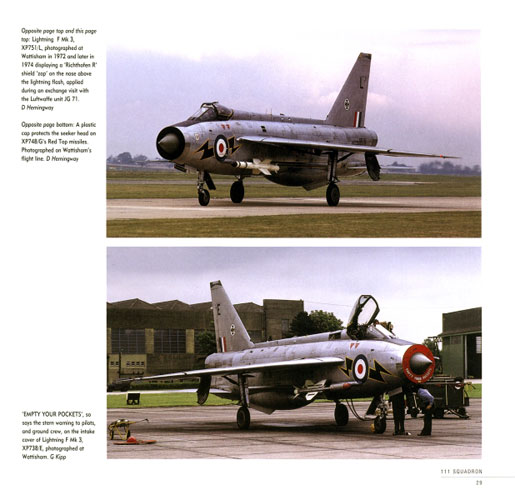|
S u m m a
r y
|
|
Title and Author |
Lightning Force -
RAF Units 1960 – 1988: A Photographic Appreciation of
the English Electric Lightning
by Fred Martin
Dalrymple & Verdun Publishing 2005 |
| ISBN: |
1-905414-00-5 |
| Media: |
Soft, glossy,
colour covers; 25cm x 24cm format, printed on 112 good
quality pages. Approximately 170 photographs, the
majority in colour. |
| Price: |
GBP£19.95 plus
postage and packing available online from Dalrymple &
Verdun Publishing |
| Review Type: |
First Read |
|
Advantages: |
Superb quality
colour photographs and useful operating squadron
histories. |
|
Disadvantages: |
|
|
Recommendation: |
Highly Recommended |
Reviewed by Steve Naylor

HyperScale is proudly supported by Squadron.com
First published in 2005, 'Lightning Force' is, to date, this
publisher's only 'photographic appreciation' of a particular
aircraft. The author Fred Martin is a lifelong fan of the
Lightning and has apparently been photographing military
aviation since the age of twelve.
Presented in an almost square format, the book is printed on
good quality paper and is packed with superb colour photographs,
augmented as necessary with only a handful of black and white
images. The introduction is written by George Black (Air Vice
Marshall, RAF Retired) and includes a photograph of all thirteen
of 111 Squadron's Lightnings (led by him) in tight formation in
1965. The remaining ten chapters include nine on the RAF
Lightning squadrons extant during the period (in order; No.'s
74, 56, 111, 19, 92, 23, 5, 11 and 29) as well as a final
chapter on the training and second-line units.
Each squadron's chapter begins with a two page description of
the Lightning's arrival, introduction, operation and eventual
withdrawal, each 'story' dependant on the squadron's role and
ultimate fate. The first page of this text is printed on a dark
grey/blue background, whilst the second page's text is backed by
a black and white photograph of an appropriate representative
Lightning. Also on the second text page, there is an
illustration of each squadron's badge and a 'box-out', listing:
the aircraft type flown prior to the Lighting's arrival; the
variant(s) of Lightning flown (with dates); bases operated from
and dates where applicable; date of disbandment; aircraft types
subsequently flown by the squadron (to the date of publishing);
and finally, a description of the squadron badge, motto and
translation.

Following each two-page introduction, the remaining pages in
each chapter are devoted to the excellent colour photographs of
that squadron's Lightnings in service. Most chapters have half a
dozen or so pages of these photographs, but the last chapter on
training and second-line units, boasts twenty. On the very rare
occasion where colour is unavailable, a similarly high quality
black and white photograph is used instead. Two photographs per
page is the maximum here (with a few dedicated to only one),
thus ensuring that full justice is done to the high quality
images on offer and allowing the viewer to study each aircraft
in some detail. Indeed, if any modellers needed a reference for
just how diverse natural metal finishes (NMF) are, they could do
no worse than to purchase this book for that reason alone. Each
photograph is captioned with appropriate information and even
those not taken by author Fred Martin are of equally high
quality. Apart from the few used to put his collection into
context, 'none of these photographs have been published in book
form before'.
Although I have no particular desire to build a model of a
Lightning myself, this aeroplane is still an evocative one for
me. My first encounter with it came as a child during a family
holiday to North Devon (UK) in the 1960's, when we attended an
open day at RAF Chivenor. Probably the last time I witnessed one
flown 'in anger', was at the International Air Tattoo at
Greenham Common in 1976. The sight and sound(!) of a Lightning
reheat take off is one not easily forgotten, especially when
that aircraft then just sits on its tail and disappears
vertically out of sight and up into the 'blue'!
'Lightning Force' certainly captures the essence of English
Electric's most famous creation - you can almost hear (and
feel!) the sound, and sense the heat and smell of 'cooking'
airframe in this book. Perhaps my description is a little
over-dramatic (maybe 'you had to be there'?), but I'm sure
modeller's will find a great deal here to whet their appetites
and do their models justice. Failing that, any aviation
enthusiast will find this a useful title, reminding us of the
remarkable design which replaced the Javelin and protected these
(and other) shores during the Cold War period.
Highly Recommended.
Thanks to Dalrymple & Verdun Publishing for the
sample
Copies should
be available to order from most good book stores, but may also
be ordered direct from:
Dalrymple &
Verdun Publishing
33 Adelaide Street
Stamford
Lincolnshire
England
PE9 2EN
(UK)
mail@dvpublishing.co.uk
www.dvpublishing.co.uk
Review Copyright © 2007 by
Steve Naylor
This Page Created on 26 February, 2007
Last updated 24 December, 2007
Back to HyperScale
Main Page
|
Home
| What's New |
Features |
Gallery |
Reviews |
Reference |
Forum |